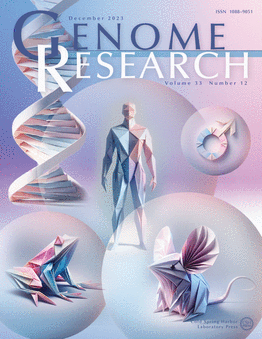利用 TREAT 和 otter 分析长读程测序平台的串联重复复杂性
IF 6.2
2区 生物学
Q1 BIOCHEMISTRY & MOLECULAR BIOLOGY
引用次数: 0
摘要
串联重复序列(TR)在人类基因组变异和疾病风险中发挥着重要作用。长读数测序可以准确鉴定 TRs,然而,其背后的生物信息学视角仍具有挑战性。我们介绍了 otter 和 TREAT:otter 是一种快速定向局部组装器,可在不同测序平台上交叉兼容。它集成在 TREAT 中,TREAT 是一个用于 TR 特征描述、可视化和多基因组分析的端到端工作流程。在与基于牛津纳米孔技术公司(ONT、Simplex 和 Duplex)和 PacBio 公司(Sequel 2 和 Revio)长线程测序数据的现有工具的比较中,otter 和 TREAT 实现了最先进的基因分型和图案表征准确性。将 TREAT/otter 应用于临床相关的 TR 时,能显著识别出具有致病性 TR 扩增的个体。当应用于病例对照环境时,我们显著地重复了之前报道的 TR 与阿尔茨海默病的关联,包括 APOC1(p=2.63x10-9)、SPI1(p=6.5x10-3)和 ABCA7(p=0.04)基因附近或内部的 TR。我们使用 TREAT/otter 系统地评估了使用不同 ONT 和 PacBio 长读程测序数据集对 TR 进行基因分型时可能出现的偏差。我们发现,在极少数情况下(0.06%),长线程测序会导致TRs的覆盖率下降,包括ABCA7和RFC1基因中的疾病相关TRs。这种覆盖率下降可能会导致TR错误分型,阻碍TR等位基因的准确鉴定。综上所述,我们的工具可以在不同测序技术中以最低的要求对TR进行准确的基因分型,从而对人类基因组中的TR进行端到端的分析和比较,在研究和临床领域有着广泛的应用。本文章由计算机程序翻译,如有差异,请以英文原文为准。
Characterising tandem repeat complexities across long-read sequencing platforms with TREAT and otter
Tandem repeats (TR) play important roles in genomic variation and disease risk in humans. Long-read sequencing allows for the accurate characterization of TRs, however, the underlying bioinformatics perspectives remain challenging. We present otter and TREAT: otter is a fast targeted local assembler, cross-compatible across different sequencing platforms. It is integrated in TREAT, an end-to-end workflow for TR characterization, visualization and analysis across multiple genomes. In a comparison with existing tools based on long-read sequencing data from both Oxford Nanopore Technology (ONT, Simplex and Duplex) and PacBio (Sequel 2 and Revio), otter and TREAT achieved state-of-the-art genotyping and motif characterisation accuracy. Applied to clinically relevant TRs, TREAT/otter significantly identified individuals with pathogenic TR expansions. When applied to a case-control setting, we significantly replicated previously reported associations of TRs with Alzheimer's Disease, including those near or within APOC1 (p=2.63x10-9), SPI1 (p=6.5x10-3) and ABCA7 (p=0.04) genes. We used TREAT/otter to systematically evaluate potential biases when genotyping TRs using diverse ONT and PacBio long-read sequencing datasets. We showed that, in rare cases (0.06%), long-read sequencing suffers from coverage drops in TRs, including the disease-associated TRs in ABCA7 and RFC1 genes. Such coverage drops can lead to TR misgenotyping, hampering the accurate characterization of TR alleles. Taken together, our tools can accurately genotype TR across different sequencing technologies and with minimal requirements, allowing end-to-end analysis and comparisons of TR in human genomes, with broad applications in research and clinical fields.
求助全文
通过发布文献求助,成功后即可免费获取论文全文。
去求助
来源期刊

Genome research
生物-生化与分子生物学
CiteScore
12.40
自引率
1.40%
发文量
140
审稿时长
6 months
期刊介绍:
Launched in 1995, Genome Research is an international, continuously published, peer-reviewed journal that focuses on research that provides novel insights into the genome biology of all organisms, including advances in genomic medicine.
Among the topics considered by the journal are genome structure and function, comparative genomics, molecular evolution, genome-scale quantitative and population genetics, proteomics, epigenomics, and systems biology. The journal also features exciting gene discoveries and reports of cutting-edge computational biology and high-throughput methodologies.
New data in these areas are published as research papers, or methods and resource reports that provide novel information on technologies or tools that will be of interest to a broad readership. Complete data sets are presented electronically on the journal''s web site where appropriate. The journal also provides Reviews, Perspectives, and Insight/Outlook articles, which present commentary on the latest advances published both here and elsewhere, placing such progress in its broader biological context.
 求助内容:
求助内容: 应助结果提醒方式:
应助结果提醒方式:


